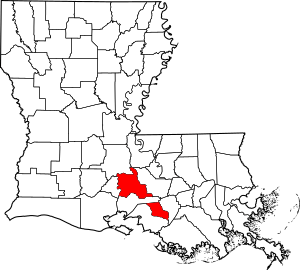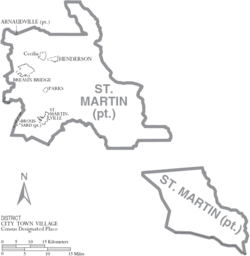St. Martin Parish, Louisiana facts for kids
Quick facts for kids
Saint Martin Parish
|
|
|---|---|

St. Martin Parish Courthouse, St. Martinville
|
|

Location within the U.S. state of Louisiana
|
|
 Louisiana's location within the U.S. |
|
| Country | |
| State | |
| Founded | 1811 |
| Named for | St. Martin |
| Seat | St. Martinville |
| Largest city | Breaux Bridge |
| Area | |
| • Total | 816 sq mi (2,110 km2) |
| • Land | 738 sq mi (1,910 km2) |
| • Water | 79 sq mi (200 km2) 9.7% |
| Population
(2020)
|
|
| • Total | 51,767 |
| • Density | 63.44/sq mi (24.494/km2) |
| Time zone | UTC−6 (Central) |
| • Summer (DST) | UTC−5 (CDT) |
| Congressional district | 3rd |
St. Martin Parish (which means Parish of Saint-Martin in French) is a special kind of county in Louisiana. It was started in 1811. The main town, called the parish seat, is St. Martinville. The biggest city in the parish is Breaux Bridge.
In 2020, about 51,767 people lived here. St. Martin Parish is part of the larger Lafayette area. It is located in a region called Acadiana, near the Gulf Coast.
Contents
History of St. Martin Parish
In 1811, parts of an older area called Attakapas Parish were used to create St. Martin Parish and St. Mary Parish. Later, in 1824, St. Martin Parish was divided again. This led to the creation of Lafayette Parish.
Then, in 1844, St. Martin Parish was split once more, forming Vermilion Parish. In 1868, Iberia Parish was created from parts of St. Martin and St. Mary parishes. Because of this, St. Martin Parish is now in two separate pieces, with Iberia Parish in between them.
Many people from France and Acadia (now part of Canada) settled in St. Martin Parish in the late 1700s. Their descendants still speak French today. This area has a large group of French-speaking people.
The Acadians brought a famous story with them about a young woman named Evangeline. The tale says she was separated from her love when the British forced the Acadians to leave their homes in Canada. The story tells that Evangeline later found her love in St. Martin Parish. But he had already found someone new. Evangeline was heartbroken. The poet Henry Wadsworth Longfellow wrote a famous poem, Evangeline, A Tale of Acadie, based on this sad story.
Evangeline became a very important symbol for Acadian and American culture. Many believe the real Evangeline was an orphan named Emmeline Labiche. She is thought to be buried at the St. Martin de Tours Catholic Church in St. Martinville.
St. Martin Parish grew quickly and became very successful in the early 1800s. Most of the money came from raising cattle. Farmers also grew important crops like cotton, sugar, corn, rice, and tobacco. These crops were sold in New Orleans.
During this time, many wealthy farmers forced African Americans to work on their large farms. By 1860, over 7,000 African Americans were forced into labor in the parish. This was a very difficult period for them.
Later, in 1855, a serious illness called yellow fever spread. Then, a big fire and a strong hurricane caused more problems. These events, along with the American Civil War and the time after it called Reconstruction, made things hard for the wealthy families. African Americans gained their freedom, but they faced many challenges as white people tried to limit their rights.
Geography and Nature
St. Martin Parish is unusual because it is split into two separate parts. This happened in 1868 due to a mistake when Iberia Parish was created. Iberia Parish sits between the two parts of St. Martin Parish, which are called Upper and Lower St. Martin.
The parish covers about 816 square miles. Most of this area, about 738 square miles, is land. The rest, about 79 square miles, is water. St. Martin Parish is located in the Atchafalaya Basin, which is a large swampy area. The Bayou Teche river flows through the parish. In the past, this bayou was used to ship goods to New Orleans.
St. Martin Parish is also known for its many beautiful oak and magnolia trees.
Protected Natural Areas
There are special areas in the parish that are protected to keep nature safe.
National Protected Area
- Atchafalaya National Wildlife Refuge (part of it is in St. Martin Parish)
State Protected Areas
- Part of the Attakapas Wildlife Management Area is in St. Martin Parish. This area is also in St. Mary and Iberia parishes.
Towns and Communities
Here are the different communities you can find in St. Martin Parish:
Cities
- Breaux Bridge (This is the biggest city.)
- Broussard (Only part of this city is in St. Martin Parish.)
- St. Martinville (This is the parish seat, where the main government offices are.)
Towns
Village
Census-designated places
These are areas that are like towns but are not officially incorporated as cities or towns.
Unincorporated communities
These are smaller communities that are not officially part of a city or town.
- Butte La Rose
- Coteau Holmes
- Gecko
- Nina Station
- Ruth
People of St. Martin Parish
| Historical population | |||
|---|---|---|---|
| Census | Pop. | %± | |
| 1830 | 7,205 | — | |
| 1840 | 8,674 | 20.4% | |
| 1850 | 11,761 | 35.6% | |
| 1860 | 12,674 | 7.8% | |
| 1870 | 9,370 | −26.1% | |
| 1880 | 12,663 | 35.1% | |
| 1890 | 14,884 | 17.5% | |
| 1900 | 18,940 | 27.3% | |
| 1910 | 23,070 | 21.8% | |
| 1920 | 21,990 | −4.7% | |
| 1930 | 21,767 | −1.0% | |
| 1940 | 26,394 | 21.3% | |
| 1950 | 26,353 | −0.2% | |
| 1960 | 29,063 | 10.3% | |
| 1970 | 32,453 | 11.7% | |
| 1980 | 40,214 | 23.9% | |
| 1990 | 43,978 | 9.4% | |
| 2000 | 48,583 | 10.5% | |
| 2010 | 52,160 | 7.4% | |
| 2020 | 51,767 | −0.8% | |
| U.S. Decennial Census 1790-1960 1900-1990 1990-2000 2010 |
|||
In 2020, there were 51,767 people living in St. Martin Parish. About 63.59% of the people were White, and about 29.07% were Black or African American. Around 3.24% of the people were Hispanic or Latino.
Many people in St. Martin Parish speak French at home. In fact, St. Martin Parish has the highest percentage of French-speaking residents of any county or parish in the United States. This shows the strong influence of the French and Acadian settlers.
The average age of people in the parish is about 37.7 years old. About 6.9% of the population is under 5 years old.
Education
Public schools in St. Martin Parish are managed by the St. Martin Parish School Board. For higher education, parts of the parish are served by South Louisiana Community College and Fletcher Technical Community College.
Transportation
Here are some of the main roads that go through St. Martin Parish:
 Interstate 10
Interstate 10 Future Interstate 49
Future Interstate 49 U.S. Highway 90
U.S. Highway 90 Louisiana Highway 31
Louisiana Highway 31 Louisiana Highway 70
Louisiana Highway 70 Louisiana Highway 94
Louisiana Highway 94 Louisiana Highway 96
Louisiana Highway 96 Louisiana Highway 182
Louisiana Highway 182 Louisiana Highway 328
Louisiana Highway 328 Louisiana Highway 347
Louisiana Highway 347 Louisiana Highway 353
Louisiana Highway 353
Notable People
Many interesting people have come from St. Martin Parish:
- Ali Landry - She won the Miss USA 1996 beauty pageant.
- Scott Angelle - He used to be a lieutenant governor and worked for the government.
- Calvin Borel - A famous horse jockey who won the Kentucky Derby three times.
- Gerald Boudreaux - A state senator for St. Martin Parish.
- Etnah Rochon Boutte - A French teacher and pharmacist.
- Jake Delhomme - A retired professional football quarterback in the NFL.
- Mike "Pete" Huval - A state representative.
- Jeff Landry - The current Governor of Louisiana. He was also the Attorney General of Louisiana and a U.S. representative.
- James D. Simon - A state senator.
See also
 In Spanish: Parroquia de St. Martin para niños
In Spanish: Parroquia de St. Martin para niños


